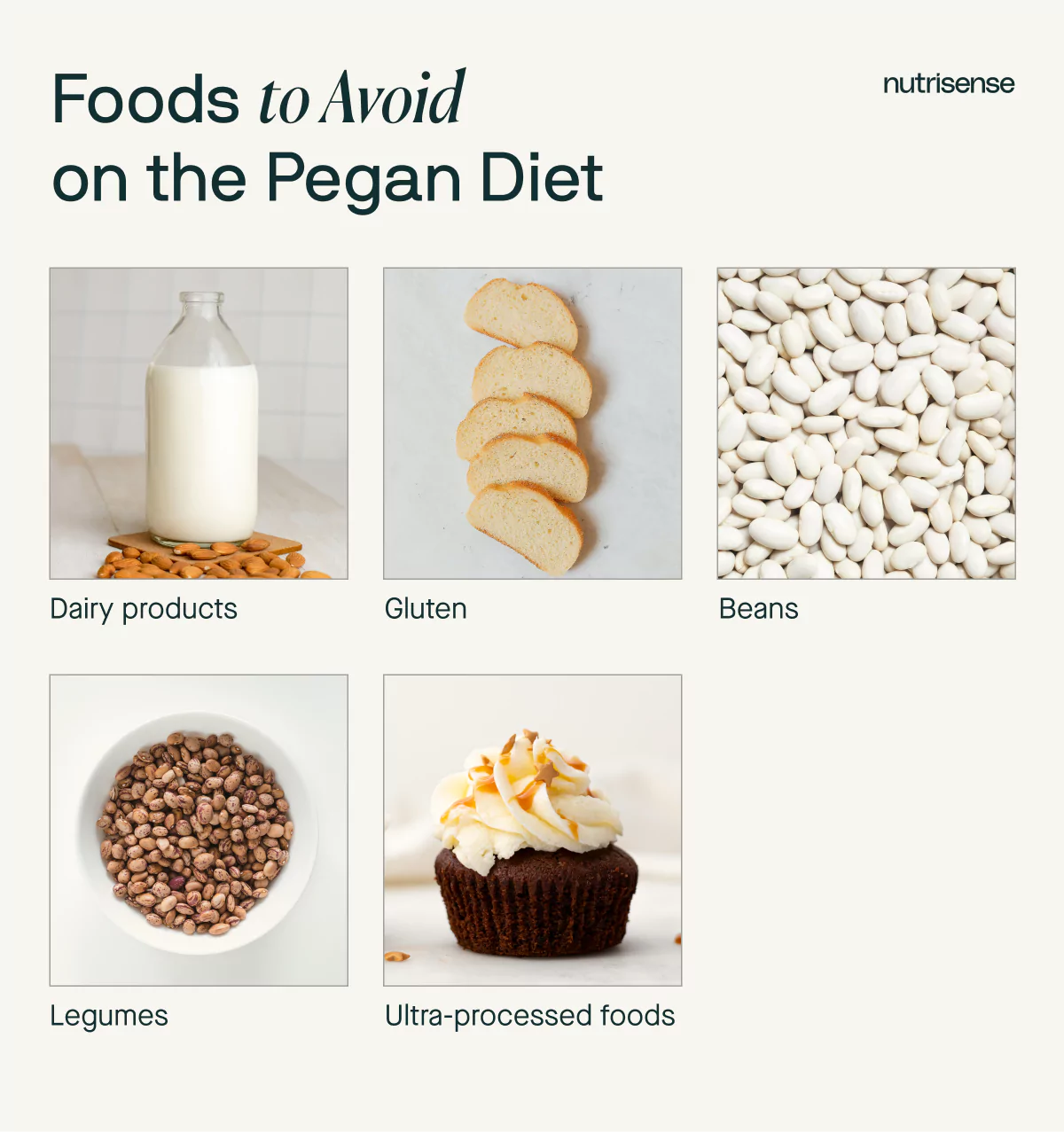The Pegan Diet: How it Works, Pros and Cons, and How it Impacts Wellness

Key Takeways
If you’re a follower of the ever-changing world of diet culture and dieting trends, there's a good chance you've already come across the pegan diet. Dr. Mark Hyman’s pegan diet has risen in popularity over recent years, combining principles from both the vegan diet and the paleo diet to combat chronic illnesses.
Although these two diets may seem like polar opposites, the pegan diet borrows principles from each way of eating to encourage the consumption of unprocessed, whole foods, while also emphasizing the importance of environmental sustainability.
Curious about whether the pegan diet is right for you? Here's everything you need to know about the pegan diet, who it’s for, and whether or not it can help you reach your goals.
What is the Pegan Diet?

The pegan diet, a phrase derived from the combination of “paleo” and “vegan,” has received significant media attention as a diet promoted for wellness and weight loss. Initially created by Dr. Mark Hyman, a functional medicine doctor, the pegan diet emphasizes the consumption of nutrient-dense foods while also advocating for a reduction in the intake of refined sugars, gluten, and dairy products.
Unlike other popular diets for weight loss, this hybrid concept claims to offer a more inclusive and balanced approach to healthy eating, focusing on the foods our ancestors once ate, while emphasizing a reduction in animal products.
As for its health benefits, however, there are limited studies that suggest that the pegan diet can be beneficial or more effective than other diets. Additionally, scientific controversy remains surrounding what exactly constitutes a diet consumed by our paleolithic ancestors.
Let’s take a look at the specific guidelines for the pegan diet as well as potential benefits and drawbacks, so that you can make informed and confident decisions about the diet you may choose to follow.
Guidelines for the Pegan Diet
Although the pegan diet merges principles from both vegan and paleolithic diets, it’s slightly less restrictive. To get a better idea of whether the pegan diet is right for you, let’s take a look at its main guidelines.
Foods to Eat

As a partially plant-based diet, the pegan diet primarily hones in on eating whole, unprocessed foods that are rich in proteins and fats while having a lower glycemic load (to avoid spiking blood sugar levels).
Here's a list of some of the main food items you can enjoy while on the pegan diet:
- Fresh fruits: Low-glycemic fruits, or fruits that are low in carbohydrates are encouraged, such as berries and citrus fruits.
- Vegetables: The pegan diet emphasizes the importance of mainly consuming non-starchy veggies, like leafy greens, zucchini, bell peppers, asparagus, and eggplant.
- Plant-based protein: The pegan diet places heavy emphasis on consuming enough protein, though much of it should be from plant-based sources such as tofu or tempeh.
- Lean animal protein: Sustainably sourced lean animal products are encouraged to eat in moderation, and can include eggs and grass-fed meats like chicken, pork, and beef.
- Fish: Fish is also allowed, but it should be relatively low-mercury options, like salmon, sardines, cod, and anchovies.
- Healthy fats: Nutrient-packed, healthy fats are also encouraged, such as chia seeds, almond butter, avocados, olive oil, and coconut oil as well as fatty fish mentioned above..
- Gluten-free whole grains: Gluten-free options like quinoa or brown rice are permitted.
Foods to Avoid

Additionally, the pegan diet details what foods you should eat in moderation or completely erase from your diet. Here's what foods to avoid or limit while on the pegan diet:
- Dairy: All dairy products should be completely avoided, including cow's milk, cheese, yogurt, and butter.
- Gluten-containing grains: Gluten products are strictly prohibited while on the pegan diet, which includes ingredients like wheat, barley, and rye (and their derived products like bread, pasta, and rice).
- Beans and legumes: While not totally off limits, beans and lentils should be consumed in very limited amounts to avoid inflammation and blood sugar spikes, according to the diet.
- Processed foods: Any processed or prepackaged snacks (including baked goods) are not allowed under this eating plan.
Additional Guidelines
The pegan diet also includes some basic principles and dieting recommendations that align with the diet’s overall philosophy. According to Dr. Hyman, your diet should consist of around 75 percent plant-based foods and 25 percent lean, sustainably sourced proteins.
In addition, something that differentiates the pegan diet from other popular dieting trends is that it encourages a more holistic and sustainable approach to nutrition, and promotes more mindful and intuitive eating practices.
Potential Benefits of the Pegan Diet

Focusing on nutrient-dense, whole foods, the pegan diet has a plethora of health benefits that many people have taken advantage of. Here are the main ways the pegan diet may contribute positively to your health and well-being.
Balanced Nutrition
Since the pegan diet combines elements from both plant-based and animal-based diets, it can provide a wide range of essential nutrients that are beneficial for overall health. The variety of foods consumed on this diet encourages a balance between different food sources which may contribute to better overall nutrition.
High in Fiber
The pegan diet strongly emphasizes consuming an abundance of fruits and vegetables which are naturally high in fiber. By regulating bowel movements and nourishing microbes, this dietary fiber helps support a healthy digestive system.
In addition, increased fiber intake may increase feelings of fullness, or satiety, which may aid in weight management. Moreover, consuming fiber-rich foods may help stabilize blood sugar levels, reduce the risk of type 2 diabetes, and help maintain a more consistent and sustainable energy supply throughout the day.
Blood Sugar Regulation
The pegan diet's focus on incorporating low-glycemic index foods and complex carbohydrates may have a slower and steadier impact on blood sugar levels, regulating glucose fluctuations and promoting better overall blood glucose control.
The emphasis on low-glycemic types of complex carbohydrates encourages eating foods rich in essential nutrients and fiber, which may contribute to a more gradual release of sugars into the bloodstream, potentially reducing the risk of insulin resistance.
Heart Health

The pegan diet's emphasis on incorporating healthy fats from sources like nuts, seeds, and olive oil as well as fatty fish, while discouraging processed foods and trans fats, can play a significant role in promoting heart health. These beneficial fats may help lower cholesterol levels, contributing to a healthier lipid profile and potentially lowering the risk of heart disease.
Also, by consuming unprocessed, whole foods, the pegan diet may support overall heart health by reducing the intake of artificial additives or preservatives.
Reduced Inflammation
The pegan diet encourages the consumption of anti-inflammatory foods, including a diverse array of fruits and vegetables, along with omega-3-rich sources like fish. These foods provide essential vitamins, minerals, and antioxidants that counteract oxidative stress and inflammation in the body.
However, it’s important to point out that due to variation in individual food tolerance and sensitivities, general guidance around so-called anti-inflammatory foods may not always present the full story. Ultimately, individual food tolerance dictates a lot about whether or not any food is pro- or anti-inflammatory.
Drawbacks of the Pegan Diet

While the pegan diet may provide a wide array of nutrients leading to success for some people, there are still some drawbacks to consider before starting the diet.
Limited Scientific Support
The pegan diet is still in its early stages of scientific exploration, so it currently has limited research specifically dedicated to studying its long-term effects. More research is still required to provide a clearer and more nuanced understanding of its long-term effects on human health.
It’s also true that many healthy dietary guidelines outside of the pegan diet already recommend limiting consumption of ultra-processed foods, and encourage whole foods-based low-glycemic protein-rich options. It may not be necessary to go full-on pegan in order to reap the benefits of some of its recommendations.
Though the pegan diet recommends eating very few if any legumes and beans, it also seems to contradict itself by recommending higher intakes of soy products. Soy is a legume. Therefore, this can be a bit confusing for people seeking to understand why one is allowable while another from the same category may not be.
Since soy is itself one of the most common food allergens, it may not be well tolerated by everyone.
Lack of Calcium and Protein
Many people on the pegan diet, especially those following the plant-based version, may face challenges getting in enough calcium and protein. Inadequate calcium intake may compromise bone health, while insufficient protein consumption may result in muscle loss or impede overall bodily functions.
Regular monitoring and consultation with a dietitian or nutritionist can help ensure a more well-rounded nutrition.
Personalization Required

Since most people have a diverse range of dietary requirements and health goals, personalization is key when following the pegan diet. Factors such as age, gender, activity level, and any existing health conditions should always be taken into account when tailoring the pegan diet to meet your needs.
Will You Have to Eat Less on the Pegan Diet?
Those on the pegan diet do not necessarily need to eat less because the diet primarily focuses on the consumption of whole foods that are naturally satiating. By emphasizing healthy foods like fruits, vegetables, high-quality proteins, and healthy fats, the diet promotes a balanced approach to eating which may help individuals feel fuller for longer.
Moreover, the diet's focus on fiber-rich foods and low-glycemic index carbohydrates can contribute to more stable blood sugar levels and sustained energy throughout the day, potentially reducing the need for excessive snacking or overeating.
Should You Try the Pegan Diet?
Like many generic dietary recommendations, the pegan diet may contain some beneficial components for some but lacks personalization and true individual customization. It may also feel unnecessarily restrictive for some people, due to it restricting many grains, legumes, and dairy products.
It’s essential to carefully manage your intake to ensure nutritional and dietary needs are fully met. Before making any significant dietary changes, seek guidance from a registered dietitian or qualified nutritionist.
Find the right Nutrisense programto turn insight into progress.
Go Beyond Glucose Data with Nutrisense
Your glucose can significantly impact how your body feels and functions. That’s why stable levels are an important factor in supporting overall wellbeing. But viewing glucose isn't enough. Nutrisense, you’ll be able to learn how to use your body's data to make informed lifestyle choices that support healthy living.
One-to-one coaching
Sign up to access insurance-covered video calls to work with a glucose expert: a personal registered dietitian or certified nutritionist who will help tailor your lifestyle and diet to your goals.
Monitor and measure what matters
With the Nutrisense CGM Program, you can monitor your glucose with health tech like glucose biosensors and continuous glucose monitor (CGM)s, and analyze the trends over time with the Nutrisense App. This will help you make the most informed choices about the foods you consume and their impact on your health.
Find your best fit
Ready to take the first step? Start with our quiz to find the right Nutrisense program to help you take control.

Heather is a Registered and Licensed Dietitian Nutritionist (RDN, LDN), subject matter expert, and technical writer, with a master's degree in nutrition science from Bastyr University. She has a specialty in neuroendocrinology and has been working in the field of nutrition—including nutrition research, education, medical writing, and clinical integrative and functional nutrition—for over 15 years.




